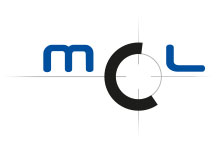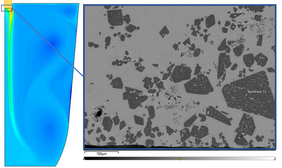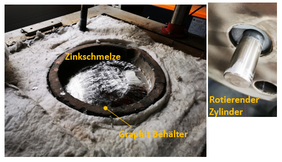In the "DigiDross" research project, a test facility was developed in the laboratory to investigate the undesired growth of Fe2Al5 particles during the hot-dip galvanizing process in more detail. The aim was to determine the growth rates under different conditions. This will make it possible to specifically reduce growth in the future in order to improve the quality of the hot-dip galvanized steel.
In continuous hot-dip galvanizing, a steel strip, which is mainly used for the production of automotive sheet metal, is coated with a protective layer of zinc to protect it from corrosion (rust) and thus ensure a longer service life. The steel strip is passed through a liquid zinc bath in which small amounts of aluminum are also present in order to improve the adhesion of the zinc coating to the steel. However, this can lead to an undesirable growth of Fe2Al5 particles on the coated sink rolls, which can lead to defects in the galvanized steel strip.
In the special experimental setup shown in Figure 2 ("RDE" for "rotating disk experiment"), a supercooled cylinder is rotated in a molten zinc enriched with aluminum and iron. By controlling the process conditions such as temperature, concentrations and rotation speed, the mass transport to the surface of the cylinder could be precisely controlled and the reaction kinetics investigated.
In addition to the experimental investigations, flow simulation models were used to better understand the experimental setup. These models made it possible to simulate the flow and transport of particles in the melt (which cannot be seen in the experiment) and to gain further insights into the formation of Fe2Al5 particles.
Impact and effects
Using these methods, it was possible to show how various process parameters influence the growth of unwanted particles. This knowledge was successfully passed on to industry in workshops and integrated into the process design. The knowledge gained is crucial for optimizing the hot-dip galvanizing process and improving the quality and service life of galvanized products such as automotive sheet metal. This also reduces the rejection rate.
The new test setup can also be used to improve the galvanizing plant itself. It will therefore continue to be used in a new research project at the COMET Center IC-MPPE. Different coating materials for the sink rolls are being developed and tested there in order to reduce the growth of Fe2Al5 particles.
Our research is a prime example of how the integration of computer simulations into experimental work opens up new possibilities. This multidisciplinary approach forms the basis for improving further metallurgical processes in various areas of materials science and engineering.
-
Project coordination (Story)
Dr. Georg Reiss
Key Scientist Digital Manufacturing Processes
Materials Center Leoben Forschung GmbH
T +43 (0) 3842 45922-44
georg.reiss(at)mcl.at
IC-MPPE / COMET-Zentrum
Materials Center Leoben Forschung GmbH
Roseggerstrasse 12
8700 Leoben
T +43 (0) 3842 45922-0
mclburo(at)mcl.at
www.mcl.at
Project partners
• International Zinc Association, USA
• Montanuniversität Leoben, Austria




















